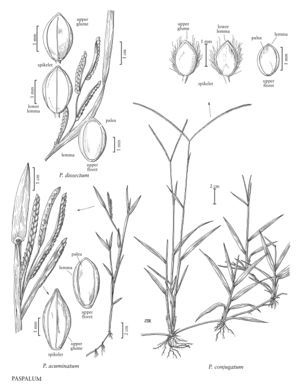Paspalum conjugatum
Plants perennial; stoloniferous. Culms 15-80 cm, erect; nodes glabrous. Sheaths glabrous, pubescent distally; ligules 0.5-0.8 mm; blades 7-23 cm long, 1.5-8 mm wide, flat. Panicles terminal, usually composed of a pair of branches, a third branch sometimes present below the terminal pair; branches 2.5-12.7 cm, diverging to spreading, often arcuate, persistent; branch axes 0.2-0.8 mm wide, glabrous, margins scabrous, terminating in a reduced spikelet. Spikelets 1.3-1.9 mm long, 0.8-1.1 mm wide, solitary, appressed to the branch axes, ovate, stramineous. Lower glumes absent; upper glumes pilose on the margins, veinless or 2-3-veined; lower lemmas glabrous, veinless or 2-3-veined; upper florets whitish to golden yellow. Caryopses 0.9-1.1 mm, white to yellow. 2n = 18, 20, 40, 80.
Distribution
Puerto Rico, Tex., La., Utah, Ala., Pacific Islands (Hawaii), Miss., Virgin Islands, Fla.
Discussion
Paspalum conjugatum is native to tropical and subtropical regions of both the Western and Eastern hemispheres, including the Flora region. It grows in disturbed areas and at the edges of forests, and is sometimes used as a lawn grass.
Selected References
None.
